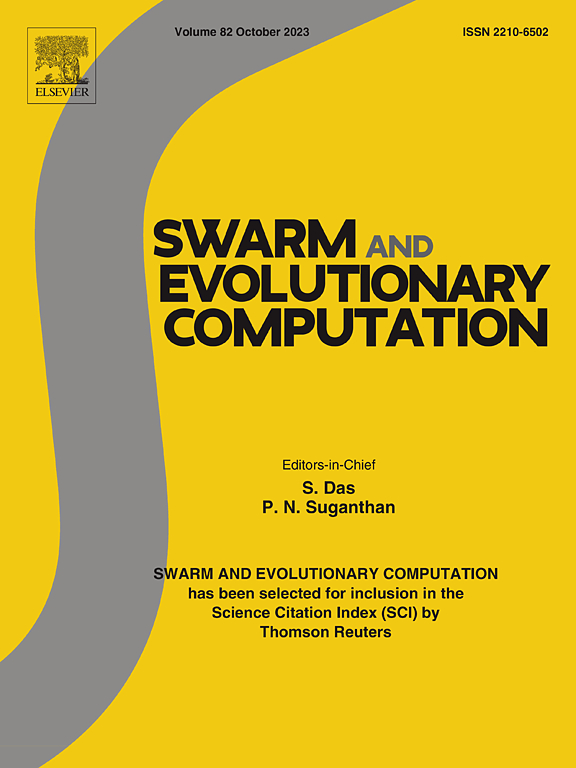An enhanced decomposition-based multi-objective evolutionary algorithm with neighborhood search for multi-resource constrained job shop scheduling problem
IF 8.2
1区 计算机科学
Q1 COMPUTER SCIENCE, ARTIFICIAL INTELLIGENCE
引用次数: 0
Abstract
Today’s industry 5.0 emphasizes the synergy between humans and equipment to raise productivity. This paper investigates a multi-resource constrained job shop scheduling problem, aiming to minimize both the makespan, the total energy consumption of automated guided vehicles (AGVs), and the total workload of workers. To address the problem, we apply an extended disjunctive graph and establish a multi-objective mixed integer linear programming model based on it. Afterward, we develop an enhanced decomposition-based multi-objective evolutionary algorithm with neighborhood search (EMOEA/D-NS) to efficiently solve this problem. In this algorithm, we design a three-layer solution representation and propose a hybrid heuristic based on priority weights to yield high-quality individuals, which comprises a congestion alleviation assignment rule for AGVs and a shortest-earliest rule for allocating workers. Furthermore, three lemmas for determining non-critical tasks are given and six neighborhood search approaches are designed to improve the quality of solutions. To enhance the exploration and exploitation capabilities of the EMOEA/D-NS, we propose a multi-rank individual-driven evolutionary mechanism that classifies the individuals into guiding, working, and following groups. For the individuals within the guiding group, we propose a self-evolution strategy that allows themselves to evolve in the way of utilizing their own experiences. For the individuals of the working group, we design a collaborative evolutionary strategy, consisting of a priority weights-based crossover and mutation operators, to evolve them with other individuals to explore promising space and exploit known space. The individuals of the following group are evolved toward the direction of those within the guiding group by an oriented evolutionary strategy, which aims to improve the quality of population and accelerate the convergence of the algorithm. Numerical experiments are carried out on 40 modified benchmarks to highlight the efficiency of the EMOEA/D-NS. Lastly, we conclude our work and outline further research directions.
求助全文
约1分钟内获得全文
求助全文
来源期刊

Swarm and Evolutionary Computation
COMPUTER SCIENCE, ARTIFICIAL INTELLIGENCEC-COMPUTER SCIENCE, THEORY & METHODS
CiteScore
16.00
自引率
12.00%
发文量
169
期刊介绍:
Swarm and Evolutionary Computation is a pioneering peer-reviewed journal focused on the latest research and advancements in nature-inspired intelligent computation using swarm and evolutionary algorithms. It covers theoretical, experimental, and practical aspects of these paradigms and their hybrids, promoting interdisciplinary research. The journal prioritizes the publication of high-quality, original articles that push the boundaries of evolutionary computation and swarm intelligence. Additionally, it welcomes survey papers on current topics and novel applications. Topics of interest include but are not limited to: Genetic Algorithms, and Genetic Programming, Evolution Strategies, and Evolutionary Programming, Differential Evolution, Artificial Immune Systems, Particle Swarms, Ant Colony, Bacterial Foraging, Artificial Bees, Fireflies Algorithm, Harmony Search, Artificial Life, Digital Organisms, Estimation of Distribution Algorithms, Stochastic Diffusion Search, Quantum Computing, Nano Computing, Membrane Computing, Human-centric Computing, Hybridization of Algorithms, Memetic Computing, Autonomic Computing, Self-organizing systems, Combinatorial, Discrete, Binary, Constrained, Multi-objective, Multi-modal, Dynamic, and Large-scale Optimization.
 求助内容:
求助内容: 应助结果提醒方式:
应助结果提醒方式:


